

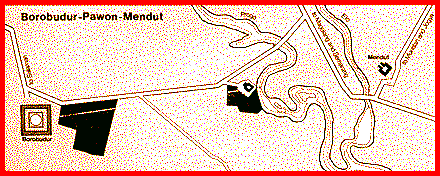
This group included in the beginning a complex of temples with hindu vocation revolving around a pyramid with steps truncated, posed on a hill, first state of Candi Borobudur. The sanctuaries related to the pyramid and still existing are Candi Pawon, Candi Mendut, and Candi Bajong whose ruins cannot be excavated because they are in the cemetery of the village of the same name.
On this pyramid will be built, at the extreme end of the 8th century the first buddhistic Borobudur (state n°2) while following the shape, the line and the orientation of the pyramid, but will be devoted to the five Jina. Unfortunately, a landslide will carry the second and third galleries and to require a complete recasting of the monument which will be undertaken from the very start of the 9thcentury. This third state will complete a score of year later.
In 832, Sanjaya reunify all the center of Java under their banner. They then try to bring back to their religious design the population by building temples hindouists right to Buddhist sanctuaries and which will include elements of Buddhist decorations, as Candi Prambanan which will be built just near the great complex of Candi Sewu and also of Candi Banon built near Candi Pawon, or by completing bouddhistic monuments by incorporating some elements in it properly hindu.
It will be the case for Borobudur which Sanjaya will take again after 932 and which they will complete by in particular building the large staircases of access (state 4), then on which they will add two new series of reliefs (state 5).
About this extraordinary monument, finally one will really never know what it would have of the being, and one does not know yet exactly what it is. The various adventures which marked out his history and its construction made it absolutely unique. No Buddhist monument around the world resembles to him, of near or by far.
Lost
in space and time, covered then drowned by the vegetation,
Borobudur will be finally found by English soldiers, under the
protectorate of Lord Raffles, in 1814. Finally in the Seventies,
under the control of UNESCO, it will be dismounted stone by
stone, then gone up like new, after the whole of the base will
have been consolidated, with addition of pipes for draining the
flow of water. New Borobudur will be finally inaugurated in 1983.
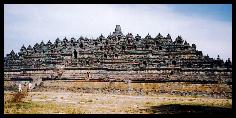 Candi Borobudur :
Candi Borobudur :Localization:
Borobudur is situated approximately 40 km in northeast of Yogyakarta, in the east of the village of Muntilan, on the slopes of the Ajamajam mount.
Stages of the realization :
Its construction started towards 780 under the reign of king Sailendra Vishnu (or Dharmatunga). The 2nd and the 3rd stage, makes a quasi whole rebuilding of it after a landslide which damaged the monument seriously, was made starting from 792 under the reign of king Indra. The fourth stage, without great modifications, was the work of Samaratunga, and the completion took place under the reign of Garung or Rakai Pikatan ?
Description:
It is Thomas Stanford Raffles who made the first description of the monument in his "History of Java", published in London in 1817.
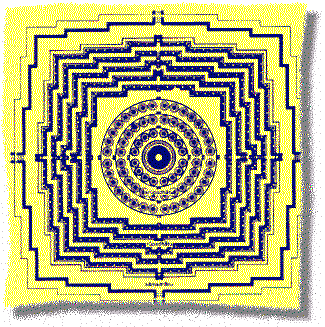
It is a monument with a quasi square base of about 113 m and 30 m top. It is composed of approximately 1 600 000 cut blocks of endesite.
The
name of Borobudur, according to the specialist in epigraphy J.G.
de Casparis, would be the contraction of an expression meaning
"the mountain of the accumulation of the merits of the ten
states of Bodhisattva",
and one finds these ten levels in the shape of ten floors which
should be climbed, after having made the turn of it , until the
large stupa central.
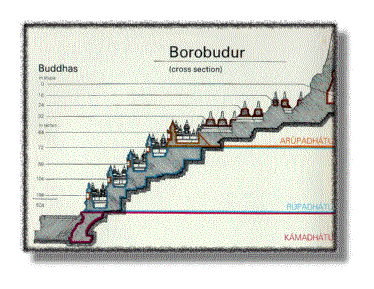
These ten floors are :
The base where are the famous hidden sculptures (visible in photographs in the museum).
The external ambulatory.
The four square terraces.
The three circular terraces.
The
platform at the top.
The
10 floors represent three divisions of the Buddhist universe:
That of the daily world or passions, called Kamadhatu (the first two stages)
That of the awakening, called Rupadhatu (square terraces).
That higher of the complete detachment, called Arupadhatu (circular terraces).
On
the monument are more than 1500 extraordinary carved panels
reporting several stories related on Buddhism and the Buddha
himself, 1200 other various decorations, 504 statues of Buddha
including 72 inside 72 small stupas openwork and posed on the
circular terraces, and at the top a large stupa of 15 m diameter
and as much top.
Significance :
Borobudur is not a temple, that is not a place of worship; it is in fact a gigantic mandala, i.e. a representation of the cosmic universe in the mahayanic Buddhism orchestrated, if one can say, by the five Jina (the one who overcame passions), which are five images of the Buddha, corresponding to five episodes significant of his life and organized according to the five directions of space. One thus has :
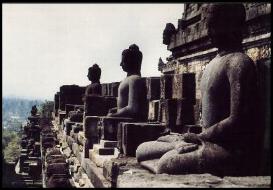
At the south, Ratnasambhava, "left from the jewel". It makes the gesture of the "gift of oneself".
At the west, Amitabha, "the infinite light". It makes it gestureof the "meditation".
At north, Amoghasiddha, "success eternal". He makes the gesture of "the absence of fear".
And
in the center, Vairochana, "the luminous one". He makes
the gesture "to turn the wheel of the Law".
Borobudur thus makes it possible to the pilgrim to meditate on his own existence, on the vacuity of the things which surround us, on the direction of the life, throughout the 2, 500 km of galleries and as one rises towards the top, that one approaches the sky.
Carved représentations :
All the galleries are covered on both sides and sometimes on two levels with carved panels, which also obliges to make ten full rotations if one wants to follow in the order all the series. One of course sought to understand this immense comic strip by recutting it with known texts.
But
because of the various stages of its animated construction, of
the modifications due also to the evolution of the religious
ideas which arrived by waves from the Indies, of the specific
convictions of each sovereign Sailendra or Sanjaya, Buddhists or
hindu, the told stories are enough disjointed, and certain series
keep mysterious.
Obviously, that harms largely the intellectual advance of the pilgrim who does not find himself there more, and it is perhaps for this reason that nowhere elsewhere, nor in any country one finds a monument which resembles closely or even by far to "this pastry ", as said Roger Vaillant.
Globally, here are the recognized texts for certain series :
Karmawibhangga is a manuscript describing the doctrines of the causes and the consequences of the good and the evil. One finds it on the hidden panels of the base, visible in the museum, but of which some have been left uncovered on the monument, on the Southern side.
Lalitavishtara which tells the life of the historical Buddha from his birth to his first sermon at Bénares. 120 panels on the first gallery, side of the wall, series top.
Jataka describe
the former lives of the Buddha in the form of 547 tales often
putting in scene animals.
Avadana are moral tales
and legends putting in scene high facts accomplished in the name
of the Buddha.
One finds Jataka and Avadana
on the first gallery under Lalitavishvara,
along the balustrade of the same gallery at top and bottom, and
along the balustrade of the second gallery.
Gandawyuya which tells the history of Sudhana in its search to reach the illumination, and its meeting with Bodhisattva Maitreya and Samentabhadra. One can follow his initiatory course on the wall of the second gallery, the wall and the balustrade of the third, and on the wall of the fourth.
Bhadrachari which continues the history of Sudhana started in Gandawyuya, with its promise to follow the example of Bodhisattva Samanthabhadra. One follows it on the wall of the fourth gallery.
![]()